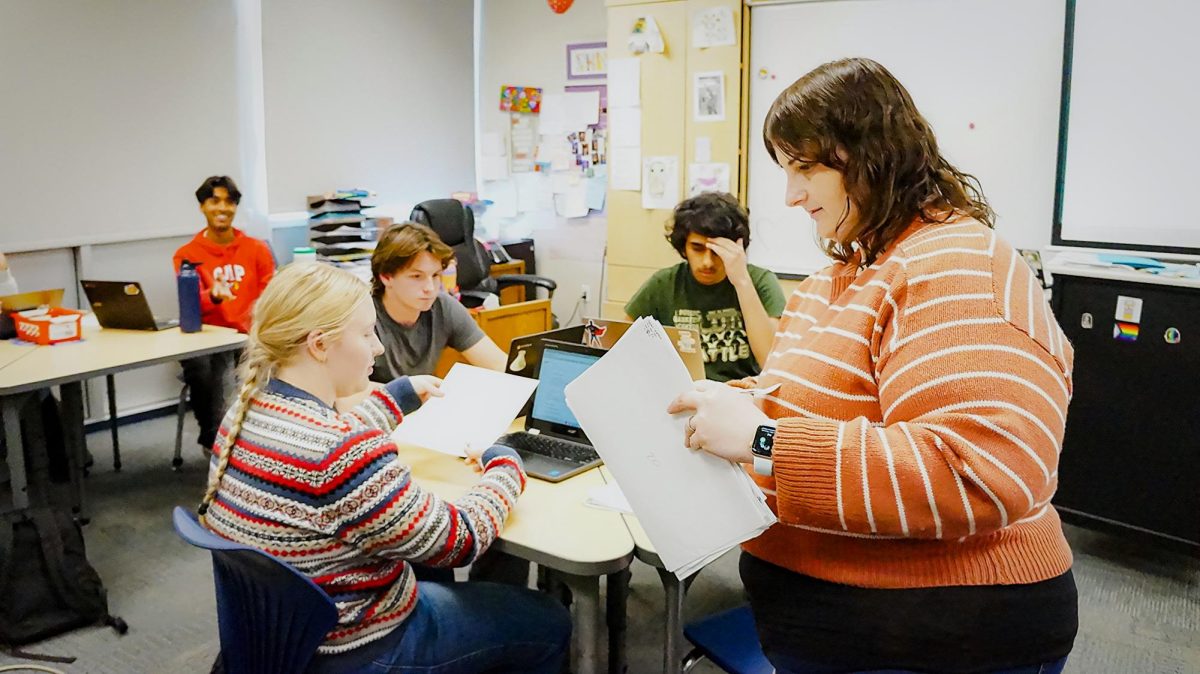Whether it is through expansive story times or rewarding ticket systems, SCHS is home to a variety of teachers, each with their own creative expression and methods of teaching. With different students rolling in every year, teachers learn to adjust the way they teach so their students are able to thrive in the classroom.
English teacher Theresa Shaw-Iyer shared that her motivation to become a teacher started while in high school. The experiences she had with her teachers are reflected in her teaching styles.
“The awesome teachers I had, they really inspired me,” Shaw-Iyer said. “My teacher, she was really fun. I was like, ‘Oh, I’m gonna be like her. She’s so cool.’”
According to Shaw-Iyer, adopting the techniques of her teachers posed a challenge at her first teaching job in King City, Calif. Managing a classroom that put in little to no effort motivated her to approach them in a different way, such as using humor.
“I found pretty quickly being super strict, teachers just did not fly with those kids,” Shaw-Iyer said. “They didn’t care, right? But I did find if I used some humor, that worked a lot better.”
Sophomore Helene Mabanta expressed her perspective on the way math teacher Paul Jacquard leads with his specific approach.
“His teaching style is that he likes to give us advice or give us principles in solving math,” Mabanta said. “His approach to teaching by principal makes us feel very empowered and independent.”
As reported by Mabanta, there is one aspect of Jacquard’s teaching style that stands out to her.
“He’s really open to us asking questions. He encourages it,” Mabanta said. “He actually rewards it and he has this ticket system, where you get tickets for participating in class, and you can use that for extra credit.”
Senior Dylan Vu shared that a couple of teachers on campus have made a substantial contribution to the improvement of his class performances, such as social studies teacher Jean Liao.
“One teacher that really impacts me the most is Ms. Liao, my macro economics teacher,” Vu said. “I think her string of long analogies really connects with me and helps me understand the topic she teaches in classes immediately.”
Likewise, Vu finds math teacher Francine Kong’s teaching mannerisms to be helpful for his learning.
“I think Kong also has a great style of teaching. Her fast paced method of learning really helps me understand all kinds of problems,” Vu said. “Her consistent pace and practicing related rates really helped me understand that chapter well.”
Mabanta further explained the clash between the way she prefers to learn and the way AP classes are taught, such as in her AP European History class.
“I understand that the College Board has this whole plan that teachers have to follow,” Mabanta said. “That learning style – independent work – you only really get guidance when you reach out for it, or if you have time to, which is a luxury for most students.”
The experiences that history teacher Carol Schmale had growing up as a student tutor helped mold her teaching styles.
“I would say that maybe it makes me more aware of how the student experience is definitely different than what I think the experience is,” Schmale said.
During her time at SCHS, Schmale said she has worked hard to appropriately accommodate students with different needs.
“My last school district wasn’t quite as diverse a population,” Schmale said. “I’ve had to really work on modifying assignments and accommodating students with different need levels.”
Nonetheless, Schmale continues to put in the effort to adjust her lessons and classroom structure, taking into account student input through surveys. As stated by Schmale, she has taken part in teacher growth programs such as “Grading with Equity.” She explained how it has helped change the structure of her teaching and how it gave her a better understanding of what needs to be met in the classroom.
“As a result of that process, I accept late work with no penalty,” Schmale said. “Kids can resubmit assignments. I allow notes on quizzes, so all my kids get to use that, no matter what.”
Both students and teachers are looking for ways to improve, understanding that there may be a way to approach the things they do in a different and more effective way. Hence, Mabanta hopes teachers can listen to advice from their own students.
“I would like to encourage teachers to look for different programs to help assist them in teaching,” Mabanta said. “I think it would be more convenient for me as a student.”


